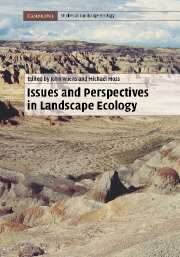Book contents
- Frontmatter
- Contents
- List of contributors
- Preface
- PART I Introductory perspectives
- PART II Theory, experiments, and models in landscape ecology
- PART III Landscape patterns
- 11 Landscape pattern: context and process
- 12 The gradient concept of landscape structure
- 13 Perspectives on the use of land-cover data for ecological investigations
- PART IV Landscape dynamics on multiple scales
- PART V Applications of landscape ecology
- PART VI Cultural perspectives and landscape planning
- PART VII Retrospect and prospect
- Index
- Plate section
- References
13 - Perspectives on the use of land-cover data for ecological investigations
from PART III - Landscape patterns
Published online by Cambridge University Press: 20 November 2009
- Frontmatter
- Contents
- List of contributors
- Preface
- PART I Introductory perspectives
- PART II Theory, experiments, and models in landscape ecology
- PART III Landscape patterns
- 11 Landscape pattern: context and process
- 12 The gradient concept of landscape structure
- 13 Perspectives on the use of land-cover data for ecological investigations
- PART IV Landscape dynamics on multiple scales
- PART V Applications of landscape ecology
- PART VI Cultural perspectives and landscape planning
- PART VII Retrospect and prospect
- Index
- Plate section
- References
Summary
An important ingredient of many research applications in landscape ecology is land-cover data. Land-cover databases reflect the patterns of vegetation, the extent of anthropogenic activity, and the potential for future uses and disturbances of the landscape. These databases are essential for studies of landscape spatial configuration and investigations of ecological status, trends, stresses, and relationships. The evolution of land-cover databases and landscape applications is an iterative process, driven by new developments at both ends. There is a strong demand at all scales for land-cover data, and those developing such data sets must constantly work toward improvements in data content, quality, and documentation to meet the diverse needs of scientific users.
The development of land-cover databases is a major focus of the US Geological Survey (USGS) National Land-cover Characterization Program. Projects span local, to regional, to global venues (e.g., Loveland et al., 1991, 2000; Vogelmann et al., 2001) and the results contribute to a wide range of applications (e.g., Jones et al., 1997, 2001; DeFries and Los, 1999; Hurtt et al., 2001; Maselli and Rembold, 2001). While some of the applications are quite innovative, we find others worrisome, considering the limitations of the source materials, mapping technologies, and expertise inherent in data development. These limitations are important to landscape ecologists because the resultant imperfections in the data sets affect the accuracy, consistency, and credibility of the analyses applied to them.
- Type
- Chapter
- Information
- Issues and Perspectives in Landscape Ecology , pp. 120 - 128Publisher: Cambridge University PressPrint publication year: 2005
References
- 5
- Cited by



